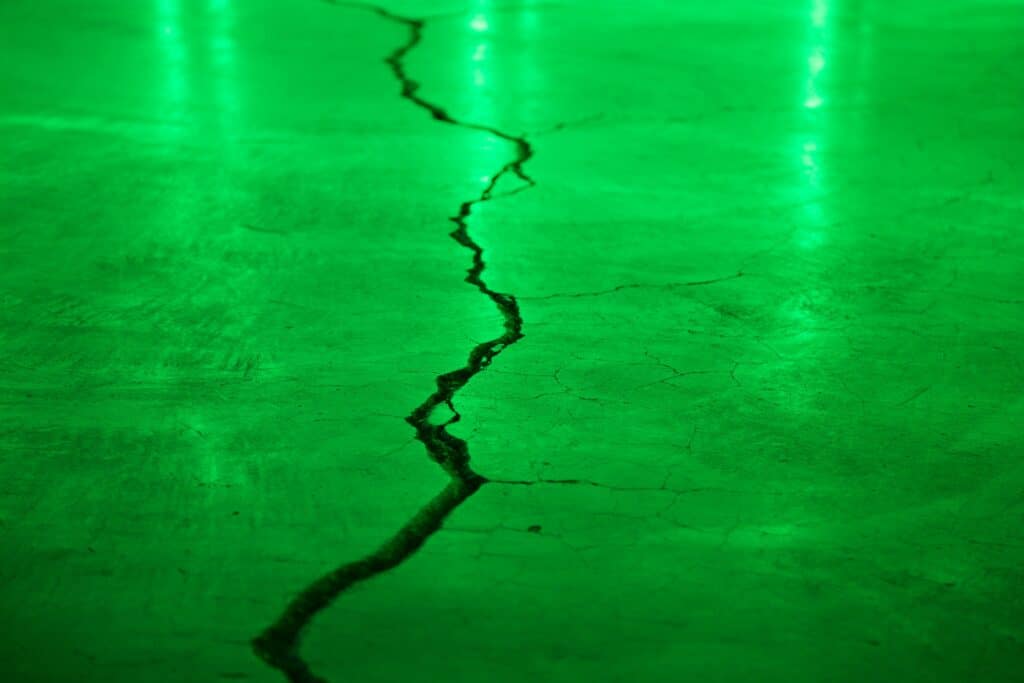Key Takeaways
- Cracks in a basement floor commonly result from concrete shrinkage, poor soil compaction, or water drainage issues. As the slab dries, fine cracks form naturally. But if they widen, cracks can create a tripping hazard or lead to wall cracks and structural problems.
- Small hairline cracks can often be patched with epoxy or concrete fillers, but larger cracks, water intrusion, or foundation-related issues may require a structural engineer’s assessment.
- Installing proper drainage, using high-PSI concrete, and applying coatings like polyurea and polyaspartic can strengthen basement floors, reduce wear, and also help manage cracks. However, nothing can completely prevent them.
“Why Is My Basement Floor Cracking?!”
Contrary to what you might think, your concrete basement floor doesn’t sit still after it’s poured: it shifts, settles, and then shrinks as it dries out. As the concrete mix dries, it shrinks up slowly like a deflating balloon, often leaving behind little cracks. Hairline cracks generally aren’t something to worry about.
In nearly all concrete walls and floors, some of these cracks tend to broaden with time. Temperature changes make it inevitable, as the concrete is constantly expanding and contracting.
If the ground wasn’t packed down tightly enough before the concrete slab was poured, the floor will move with the earth, creating bigger shrinkage cracks. In fact, the main reason why floors crack is either the ground shifting or water not draining from the foundation.
All in all, some basement floor cracks are normal, but in areas where there are lots of vibrations (like a garage), where the soil wasn’t packed correctly, or where there are no drain tiles installed, cracks can deepen and widen.
Basement Floor Cracks and Heaving
While some basement floor cracks form when concrete shrinks, others happen because the soil beneath the concrete basement floor swells up. Remember how we talked about draining the water from the foundation? Well, when the ground absorbs too much moisture, it expands, and the pressure builds. The only direction for it to go is up, so it ultimately can push on weaker parts of the concrete, leaving behind noticeable cracks in the basement. This is called heaving, and it can completely destroy your floors.
Foundation walls can also cause cracks in floors. How? If they weren’t firmly connected to the home’s foundation when the house was built, they can add extra stress to the concrete floor. While even perfectly built walls shift a little over time, when things add up the effect can be noticeable.
Types of Basement Cracks
Small hairline cracks usually pop up as a consequence of the concrete drying and shrinking. If they’re less than 1/8 inch wide, they’re typically nothing to worry about. They can generally be left alone, filled with a flexible caulk, and hidden.
Bigger cracks, on the other hand, can be a sign of a major problem — things like the home’s foundation slowly sinking or the soil shifting aggressively. These cracks can widen over time and might even let water intrusion sneak through, which is the last thing you want with concrete.
Most Basement Floor Cracks: DIY Fix or Call a Pro?
When dealing with hairline cracks, a quick patch job using an epoxy, polyaspartic basement floor coating, or concrete crack filler will usually be enough. Some of these products also seal up the floor crack and keep moisture from creeping in, making them the best solution for minor cracks.
But before paying for a repair kit on your own, it’s worth figuring out why the cracks in the basement showed up in the first place. If the concrete slab is shifting due to soil movement or water seep, your patchwork may not last for long.
When It’s Time to Call in a Pro
Not all cracks in the basement floor can be fixed with a simple patch. If you notice one of the deeper problems we mentioned before, such as water intrusion, or if the cracks are spreading into the basement walls, it’s time to call in a structural engineer.
Preventing Most Basement Cracks
The best way to prevent a large concrete slab floor from cracking is to have a good drainage system around the foundation. Installing drain tile can help move water away from your house, preventing soil from building upward pressure and pushing against the foundation walls.
Waterproofing basement walls and floors can be another helpful step. If moisture seeps into the concrete over time, it can weaken the structure and make it easier for wider cracks to develop. A well-sealed basement floor stays drier, stronger, and in good shape for years.
Concrete Floor Strengths
Not all concrete is made equal. Different mixes have different strengths and support different weights. We measure that strength in something called PSIs, the pressure felt by a square inch when a one-pound weight is applied.
The concrete mix in your patio is probably around the 2000 PSI range, usually employed for non-structural applications. But any structural engineer will tell you a column or a beam needs something closer to the 4000 PSI range, in order to handle higher pressures for longer without deforming.
Using a higher PSI concrete mix could mean a longer lifetime for garage or basement floors, which typically see a lot of movement.

Cracks in the Basement: How to Fix Them
One of the best solutions for small basement floor cracks that are more nuisance than structural is to fill them in and seal them up before they get worse. This helps prevent moisture infiltration and adds an extra layer of durability.
Polyurea and polyaspartic top coats are a go-to material for sealing cracks in the basement floor. They harden fast but stay flexible enough to handle minor shifts without cracking again. Other options, like epoxy injections, can also help restore the surface and give the concrete floor a smoother, more even finish.
Radon Gas and Basement Cracks
Basement cracks don’t just let in water — they can also be an entry point for radon gas. This radioactive gas seeps up from the soil and can pose serious health risks if it accumulates indoors. We’ll save HOW a radioactive gas comes from the soil for another time, but trust us on this one. While you should definitely have a radon detector in your house, sealing cracks properly is one step to keeping those levels under control.
Pour Concrete Like a Pro
One of our secrets for minimizing foundation cracks or settling cracks in the basement floor is a good coating.
Coating a basement floor adds an extra layer of protection, but it can’t 100% stop concrete from cracking. What it CAN do is help reduce surface wear and keep the concrete basement floor in good shape for longer – and looking great too!
We use polyurea as a base coat because it dries quickly and has just enough flexibility to move with the slab instead of cracking. A top layer of polyaspartic adds even more durability and makes the basement floor look sleek and polished. While professional concrete coatings won’t prevent every floor crack, they kind of fill in the cracks that form naturally in the concrete, acting as expansion joints.
If you’ve got questions or would like a free quote for a concrete coating in the Finger Lakes, we’d love to connect. We serve Syracuse, Rochester, Watkin’s Glen, and everything in between. Call today to learn more!





